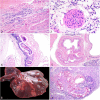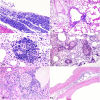Pathology of wild Norway rats in Vancouver, Canada
- PMID: 30852980
- PMCID: PMC6838826
- DOI: 10.1177/1040638719833436
Pathology of wild Norway rats in Vancouver, Canada
Abstract
To achieve a contemporary understanding of the common and rare lesions that affect wild, urban Norway rats ( Rattus norvegicus), we conducted a detailed pathology analysis of 672 rats from Vancouver, British Columbia, Canada. Grossly evident lesions, such as wounds, abscesses, and neoplasms, were present in 71 of 672 rats (11%) and tended to be severe. The most common and significant lesions were infectious and inflammatory, most often affecting the respiratory tract and associated with bite wounds. We assessed a subset of rats (up to n = 406 per tissue) for the presence of microscopic lesions in a variety of organ systems. The most frequent lesions that could impact individual rat health included cardiomyopathy (128 of 406; 32%), chronic respiratory tract infections as indicated by pulmonary inducible bronchus-associated lymphoid tissue (270 of 403; 67%), tracheitis (192 of 372; 52%), and thyroid follicular hyperplasia (142 of 279; 51%). We isolated 21 bacterial species from purulent lesions in rats with bacterial infections, the most frequent of which were Escherichia coli, Enterococcus sp., and Staphylococcus aureus. Parasitic diseases in rats resulted from infection with several invasive nematodes: Capillaria hepatica in the liver (242 of 672; 36%), Eucoleus sp. in the upper gastrointestinal tract (164 of 399; 41%), and Trichosomoides crassicauda in the urinary bladder (59 of 194; 30%). Neoplastic, congenital, and degenerative lesions were rare, which likely reflects their adverse effect on survival in the urban environment. Our results establish a baseline of expected lesions in wild urban rats, which may have implications for urban rat and zoonotic pathogen ecology, as well as rat control in cities worldwide.
Keywords: Bacterial infections; Rodentia; parasitic diseases; pathology; trauma.
Conflict of interest statement
Figures




References
-
- Anholt H, et al. Ear mange mites (Notoedres muris) in black and Norway rats (Rattus rattus and Rattus norvegicus) from inner-city Vancouver, Canada. J Wildl Dis 2014;50:104–108. - PubMed
-
- Athanazio DA, et al. Rattus norvegicus as a model for persistent renal colonization by pathogenic Leptospira interrogans. Acta Trop 2008;105:176–180. - PubMed
-
- Balfour A. Observations on wild rats in England, with an account of their ecto- and endoparasites. Parasitology 1922;14:282–298.
MeSH terms
LinkOut - more resources
Full Text Sources
Medical

